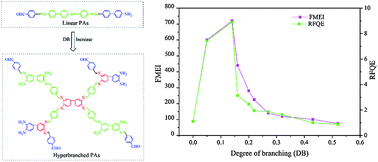Effect of branching architecture on the optical properties of polyazomethines†
Abstract
The architecture of

* Corresponding authors
a
Instrumental Analysis Center, Shanghai Jiao Tong University, 800 Dongchuan Road, Shanghai, P. R. China
E-mail:
bshzhu@sjtu.edu.cn
Fax: +86-21-34205722
Tel: +86-21-34206173-402
b
School of Chemistry and Chemical Engineering, State Key Laboratory of Metal Matrix Composites, Shanghai Jiao Tong University, 800 Dongchuan Road, Shanghai, P. R. China
E-mail:
xyzhu@sjtu.edu.cn
Fax: +86-21-34205722
Tel: +86-21-34205699
The architecture of

 Please wait while we load your content...
Something went wrong. Try again?
Please wait while we load your content...
Something went wrong. Try again?
H. Deng, B. Zhu, L. Song, C. Tu, F. Qiu, Y. Shi, D. Wang, L. Zhu and X. Zhu, Polym. Chem., 2012, 3, 421 DOI: 10.1039/C1PY00486G
To request permission to reproduce material from this article, please go to the Copyright Clearance Center request page.
If you are an author contributing to an RSC publication, you do not need to request permission provided correct acknowledgement is given.
If you are the author of this article, you do not need to request permission to reproduce figures and diagrams provided correct acknowledgement is given. If you want to reproduce the whole article in a third-party publication (excluding your thesis/dissertation for which permission is not required) please go to the Copyright Clearance Center request page.
Read more about how to correctly acknowledge RSC content.
 Fetching data from CrossRef.
Fetching data from CrossRef.
This may take some time to load.
Loading related content
